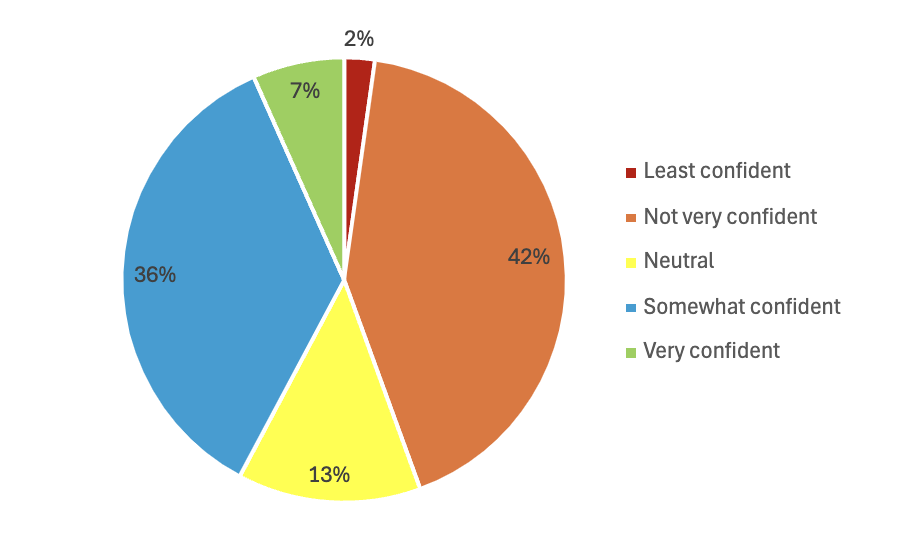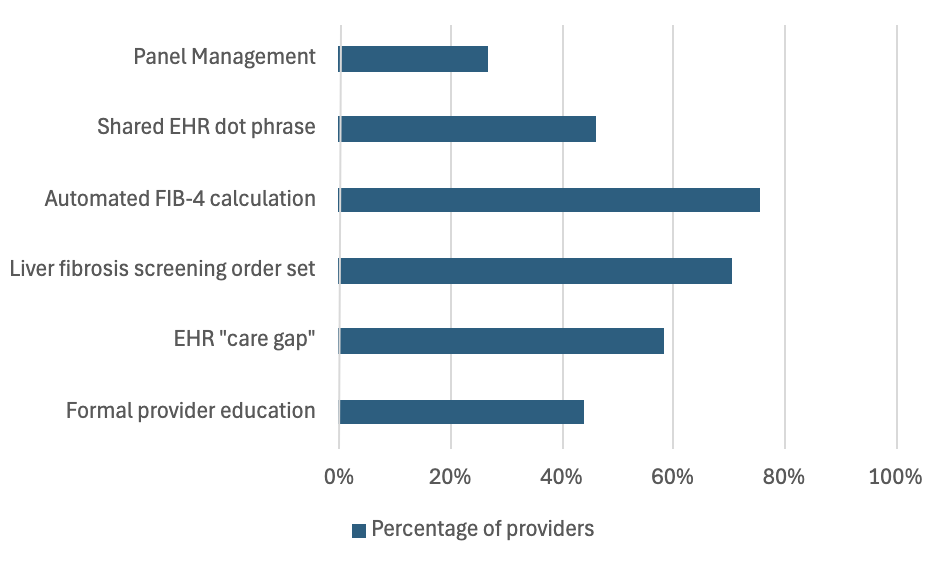Monday Poster Session
Category: Liver
P3805 - Targeted Liver Fibrosis Assessment in Patients With Metabolic Dysfunction: Surveying the Front Line
Monday, October 27, 2025
10:30 AM - 4:00 PM PDT
Location: Exhibit Hall

Jason Barbaretta, MD
University of Nebraska Medical Center
Omaha, NE
Presenting Author(s)
Jason Barbaretta, MD, Andjela Drincic, MD, Sarah Azad, MBBS, Shubham Agarwal, MBBS, Caressa Trueman, PharmD, Kyle Scholten, DO, Zach Vinton, DO
University of Nebraska Medical Center, Omaha, NE
Introduction: Metabolic dysfunction-associated steatotic liver disease (MASLD) has a global prevalence of over 25%. Multiple societies recommend targeted screening for clinically significant liver fibrosis in patients with metabolic risk factors. Primary care physicians and endocrinologists are on the front line of identifying and managing metabolic dysfunction. This study assesses the knowledge and practice patterns of these groups regarding targeted liver fibrosis screening. We also identify perceived barriers and potential interventions for enhancing liver fibrosis screening.
Methods: A cross-sectional survey study was conducted at a single academic medical center. A total of 133 internal medicine and endocrinology faculty and trainees were invited to participate voluntarily. Recruitment and survey administration were conducted through REDCap. The survey consisted of multiple choice and short answer questions related to several aspects of targeted liver fibrosis screening.
Results: Of the initial 133 subjects recruited, 44 individuals completed the survey (response rate of 33%). Only 43% of respondents felt confident identifying who should be screened for clinically significant liver fibrosis, and 43% felt confident interpreting screening results. 32% of respondents “rarely” or “never” perform targeted liver fibrosis screening. The most common barriers to screening were uncertainty regarding who to screen (63%), time restraints (54%), and lack of prompting within the electronic health records (EHR) (49%). The most favorable potential tools to prompt initial screening were an automated FIB-4 calculator (76%), a liver fibrosis screening order set (71%), and an EHR “care gap” (59%). The most desirable ways to aid FIB-4 score interpretation were embedded guidance within the EHR following an automated FIB-4 calculation (85%), embedded guidance through a liver fibrosis screening order set (63%), and a shared dot phrase (43%).
Discussion: Despite existing diagnostic frameworks, targeted liver fibrosis assessment in the primary care setting is lagging. The perceived barriers and desired interventions identified in this study emphasize an opportunity to enhance liver fibrosis screening by leveraging tools within existing EHR software. EHR-based changes often require significant buy-in at the institutional level. This study hopes to accelerate change by first highlighting buy-in from the physicians who are most responsible for diagnosing liver fibrosis in patients with metabolic dysfunction.

Figure: Physician self-reported confidence regarding who to screen for clinically significant liver fibrosis

Figure: Proportion of physicians who would find each intervention helpful in identifying who to screen for clinically significant liver fibrosis
Disclosures:
Jason Barbaretta indicated no relevant financial relationships.
Andjela Drincic indicated no relevant financial relationships.
Sarah Azad indicated no relevant financial relationships.
Shubham Agarwal indicated no relevant financial relationships.
Caressa Trueman indicated no relevant financial relationships.
Kyle Scholten indicated no relevant financial relationships.
Zach Vinton indicated no relevant financial relationships.
Jason Barbaretta, MD, Andjela Drincic, MD, Sarah Azad, MBBS, Shubham Agarwal, MBBS, Caressa Trueman, PharmD, Kyle Scholten, DO, Zach Vinton, DO. P3805 - Targeted Liver Fibrosis Assessment in Patients With Metabolic Dysfunction: Surveying the Front Line, ACG 2025 Annual Scientific Meeting Abstracts. Phoenix, AZ: American College of Gastroenterology.
University of Nebraska Medical Center, Omaha, NE
Introduction: Metabolic dysfunction-associated steatotic liver disease (MASLD) has a global prevalence of over 25%. Multiple societies recommend targeted screening for clinically significant liver fibrosis in patients with metabolic risk factors. Primary care physicians and endocrinologists are on the front line of identifying and managing metabolic dysfunction. This study assesses the knowledge and practice patterns of these groups regarding targeted liver fibrosis screening. We also identify perceived barriers and potential interventions for enhancing liver fibrosis screening.
Methods: A cross-sectional survey study was conducted at a single academic medical center. A total of 133 internal medicine and endocrinology faculty and trainees were invited to participate voluntarily. Recruitment and survey administration were conducted through REDCap. The survey consisted of multiple choice and short answer questions related to several aspects of targeted liver fibrosis screening.
Results: Of the initial 133 subjects recruited, 44 individuals completed the survey (response rate of 33%). Only 43% of respondents felt confident identifying who should be screened for clinically significant liver fibrosis, and 43% felt confident interpreting screening results. 32% of respondents “rarely” or “never” perform targeted liver fibrosis screening. The most common barriers to screening were uncertainty regarding who to screen (63%), time restraints (54%), and lack of prompting within the electronic health records (EHR) (49%). The most favorable potential tools to prompt initial screening were an automated FIB-4 calculator (76%), a liver fibrosis screening order set (71%), and an EHR “care gap” (59%). The most desirable ways to aid FIB-4 score interpretation were embedded guidance within the EHR following an automated FIB-4 calculation (85%), embedded guidance through a liver fibrosis screening order set (63%), and a shared dot phrase (43%).
Discussion: Despite existing diagnostic frameworks, targeted liver fibrosis assessment in the primary care setting is lagging. The perceived barriers and desired interventions identified in this study emphasize an opportunity to enhance liver fibrosis screening by leveraging tools within existing EHR software. EHR-based changes often require significant buy-in at the institutional level. This study hopes to accelerate change by first highlighting buy-in from the physicians who are most responsible for diagnosing liver fibrosis in patients with metabolic dysfunction.

Figure: Physician self-reported confidence regarding who to screen for clinically significant liver fibrosis

Figure: Proportion of physicians who would find each intervention helpful in identifying who to screen for clinically significant liver fibrosis
Disclosures:
Jason Barbaretta indicated no relevant financial relationships.
Andjela Drincic indicated no relevant financial relationships.
Sarah Azad indicated no relevant financial relationships.
Shubham Agarwal indicated no relevant financial relationships.
Caressa Trueman indicated no relevant financial relationships.
Kyle Scholten indicated no relevant financial relationships.
Zach Vinton indicated no relevant financial relationships.
Jason Barbaretta, MD, Andjela Drincic, MD, Sarah Azad, MBBS, Shubham Agarwal, MBBS, Caressa Trueman, PharmD, Kyle Scholten, DO, Zach Vinton, DO. P3805 - Targeted Liver Fibrosis Assessment in Patients With Metabolic Dysfunction: Surveying the Front Line, ACG 2025 Annual Scientific Meeting Abstracts. Phoenix, AZ: American College of Gastroenterology.

